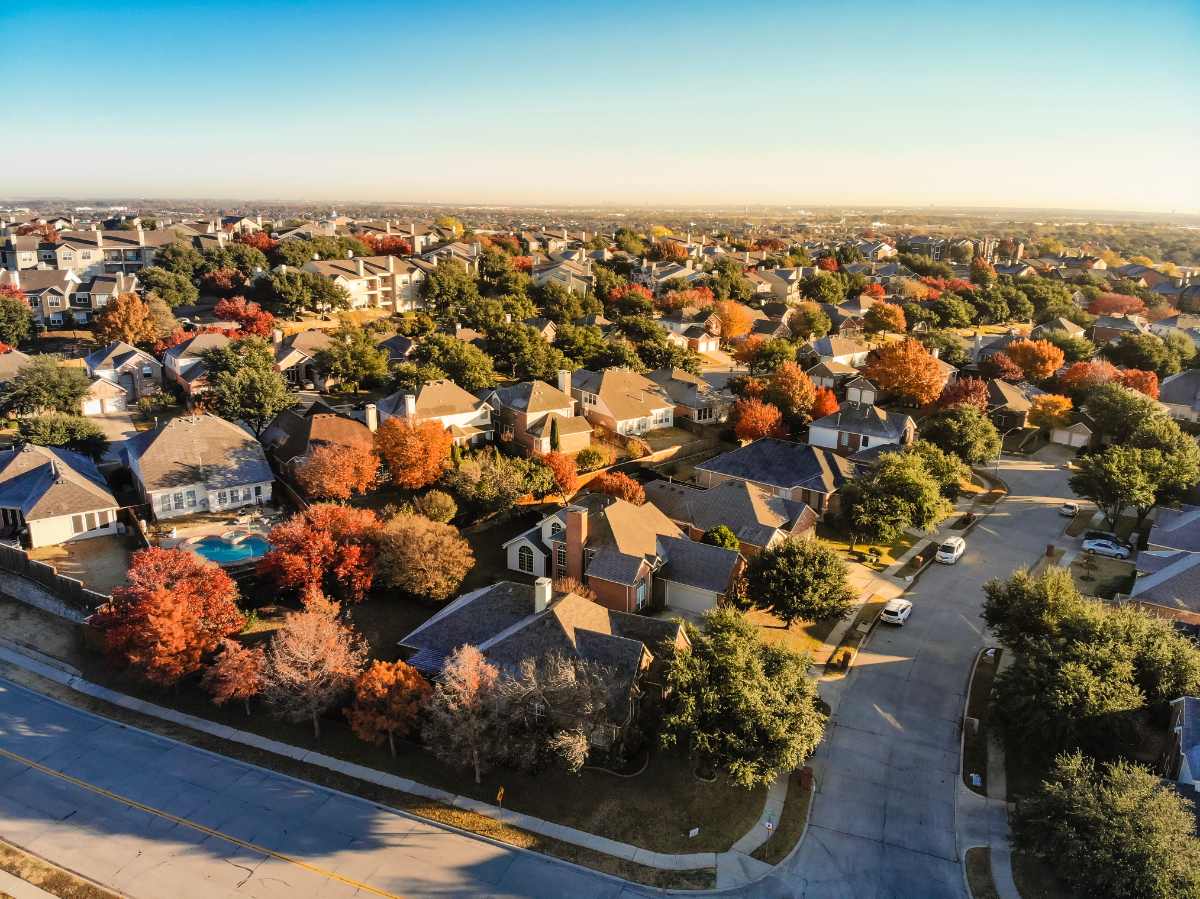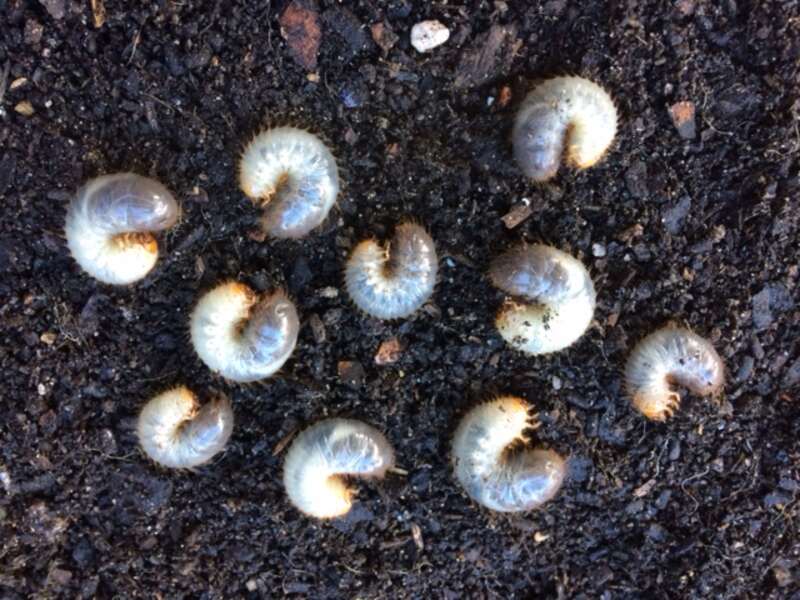
As the cooler weather moves in through North Texas, so does a new set of lawn care chores. Our guide to fall lawn care in Dallas walks you through the 9 steps to cultivate a healthy lawn.
Learn the right time to apply pre-emergent herbicides, the best soil temperatures for overseeding Bermuda in November, when you can stop mowing and irrigating your yard, and much more. From fall fertilizing to yard cleanup, here’s everything you need to do to create the perfect Dallas lawn this fall.
1. Mow Growing Grass

How often to mow warm-season grasses: Mow warm-season grasses less frequently as their growth slows, usually about one mow every 1.5 weeks. Expect your grass to go dormant when soil temperatures reach around 50 degrees F.
The weather also affects your mowing schedule. Rainfall increases grass growth, so you may have to mow sooner after a rainstorm. But regardless of rainfall, as temperatures cool, the growth rate of your grass will slow down, reducing your mowing frequency.
Why you should mulch your clippings: “AgriLife’s Earth-Kind Principles recommend that all homeowners mulch their grass clippings in place on the lawn,” says Jay Caddel, county Extension agent for Tarrant County at Texas A&M AgriLife Extension. “These clippings break down and add organic matter to the soil. This also alleviates grass clippings from going to the landfill.”
When to stop mowing: Depending on your Dallas grass type, these are the times of year when you can stop mowing your lawn before winter:
| Type of Grass | When to Stop Mowing in the Fall |
| Bermudagrass | November to December |
| Centipedegrass | November |
| St. Augustinegrass | November |
| Zoysiagrass | November |
My Tip: For my family’s Denton lawn, my dad reduces his mowing frequency in August. During September and October, he mows his lawn every 1.5 weeks depending on the turfgrass’s growth rate. In November, he does his final mow of the season.
No time to mow? LawnStarter has you covered. Hire a Dallas lawn care pro to mow your lawn and take care of your other fall lawn care chores.
See Related: Mulching vs. Bagging Grass Clippings
2. Water Your Lawn Properly
To prevent most of the water from evaporating before it reaches the soil, water the lawn in the morning before 10 a.m.
Your lawn needs less water as the weather cools down, and most warm-season lawns in Dallas go dormant by November. Don’t water warm-season grasses once they are dormant, as this can lead to fall lawn diseases such as large patch.
See Related:
3. Clean Up Your Yard
In autumn, falling leaves create a messy lawn, which reduces curb appeal and affects the health of your lawn. Here are ways to get rid of fallen leaves and other debris, such as branches and twigs:
- Rake leaves or use a leaf blower to make leaf removal easier.
- Mulch leaves with a mulching lawn mower. Mulching mowers shred leaves and grass clippings into smaller pieces and return them to your lawn as natural mulch. This nourishes your lawn by adding nutrients and helps insulate the soil going into winter.
Dallas Pro Tip (from Jose Tovar of Tovar Landscaping): “My No. 1 tip for lawn maintenance in the fall is to have your lawn clear of leaves so that it doesn’t develop spots with missing grass.”
Fall leaves can leave your yard a mess. LawnStarter can take care of raking the leaves for you with our leaf removal service.
Read More:
4. Treat Lawn Pests

Fall is a good time to treat for lawn pests. To control white grubs, apply treatment, if needed, in September and October.
Also, search your yard for fall armyworms. Treat them if your yard has a large fall armyworm infestation.
See Related:
5. Treat Weeds

Weeds are a year-round issue in Dallas, so consistent weed control is essential to proper fall lawn care. Apply pre-emergent herbicides when the soil temperature drops to 70 degrees F, typically around mid-October.
Dallas Pro Tip (from Cole Duncan of Lone Star Mow Co.): “I always recommend you have your pre-emergent done for the fall to help prevent the next wave of weeds.”
Caddel agrees, saying, “Fall is the time to apply a pre-emergent herbicide and a winter fertilizer.”
Here are some common Dallas weeds you can prevent with pre-emergents in the fall:
- Annual bluegrass
- Chickweed
- Henbit
You should incorporate multiple approaches for weed control in the fall:
- Use pre-emergent herbicides to prevent winter annual weeds.
- Apply post-emergent herbicides for small broadleaf weeds, such as clover, or grassy weeds, such as annual bluegrass, in the early fall when the air temperature is between 60 to 85 degrees F.
- Create a homemade weed killer with our recipe for vinegar weed killer.
- Pull weeds by hand to remove smaller infestations.
Note: Select a pre-emergent herbicide that is suited to the type of grass growing in your lawn. Don’t apply pre-emergent herbicides if you are going to overseed ryegrass in the fall.
| If weeds have invaded your yard, contact a Dallas lawn treatment pro to see if your lawn can be saved. We completed nearly 40,000 lawn treatment services last year at an average price of $103 per service and received an average rating of 4.4/5 from our customers. |
See Related: How to Get Rid of Weeds in Grass
6. Test Your Soil
Determine which nutrients your lawn is missing by conducting a soil test every 2 to 3 years. It will take 2 to 4 weeks for the Dallas Extension to give you the results, so test as early as possible to get your results in before you need to fertilize.
A soil test will tell you about the health and texture of your soil and let you know what fertilizer or soil amendments your yard needs, preventing under- or overfertilizing.
“We recommend performing a soil test before applying fertilizers so that you are not apply[ing] unnecessary nutrients to the soil,” says Caddel.
There are two different options for testing your soil:
- Extension soil test: Homeowners can request soil testing from Texas A&M AgriLife Extension. You will need to prepare a soil sample and pay a fee.
- DIY soil test: Purchase a DIY soil testing kit at a local garden store, or use a DIY ribbon test to figure out the texture and type of your soil.
The most common soil in Dallas is Blackland Prairie soil, an alkaline soil high in clay. Clay soils are slow to absorb water, but they also retain water longer than other soil types. Sometimes, Dallas soil is too alkaline, which hinders nutrient absorption.
The best pH level for turfgrass is between 6 and 7, so if your grass is outside this range, add soil amendments to balance the pH and promote healthy grass. Alkaline soils can be amended with sulfur, aluminum sulfate, or iron sulfate.
Loamy soil, which is a combination of clay, silt, and sand, is also common in Dallas yards. It doesn’t retain moisture as long as Dallas’s Blackland Prairie soils.
See Related:
- 5 Signs of Alkaline Soil in Your Lawn (High pH)
- How to Read a Soil Test Report
- How to Change Your Soil pH
7. Overseed Bermuda with Ryegrass

Overseeding Bermudagrass with ryegrass in the fall helps improve the density and health of your fall lawn in Texas. This will also add some green color for fall and winter.
Typically, the right temperatures for fall overseeding start around November 1st or when the soil temperature is around 60 degrees F.
8. Fertilize Your Grass
The best time to fertilize your Texas lawn is 6-8 weeks before the first frost, which occurs in November. Therefore, it’s best to fertilize your lawn in early September.
Application of a low-nitrogen fertilizer once in the fall is advised for all Texas warm-season grass types except centipede. Apply 0.5 to 1 pound of nitrogen per 1,000 square feet to improve your fall lawn’s density, color, and recovery in spring.
See Related:
9. Winterize Your Lawn Equipment
The mowing season requires regular use of mowing equipment. However, once the growing season is over, it’s time for you to put your tools and equipment into storage for the winter.
Here’s how to winterize your lawn mower to protect it during the months when it’s not in use:
- Burn off your mower’s remaining fuel (or add fuel stabilizer)
- Clean or replace your air filter
- Sharpen your lawn mower blades
- Clean the mowing deck
- Change the oil
- Check spark plugs; replace if needed
Additionally, you should also turn off the water supply to your sprinkler system and make sure it is properly drained. Otherwise, water trapped in your sprinkler pipes could freeze and damage your irrigation system.
See Related:
Make Fall Lawn Care Easy: Hire a Dallas Lawn Care Pro

As things cool down in the fall, your lawn care is still ongoing. Make sure you don’t miss the deadlines to test your soil, apply herbicides and pesticides, and overseed your grass this fall.
From leaf removal to lawn mowing, LawnStarter’s Dallas lawn care pros can take care of your fall lawn care to-do list.
Our lawn care services don’t stop within the Dallas city limits. LawnStarter has pros in Irving, Arlington, Richardson, Plano, and all across the DFW area. With our app, you can click, call, or book LawnStarter’s lawn care services with the touch of a button.
Read Next:
Sources:
- “Bermudagrass Home Lawn Management Calendar.” By Casey Reynolds, Extension turfgrass specialist, and Matt Elmore, Extension turfgrass specialist. Texas A&M AgriLife Extension.
- “Chilling Hours/First and Last Frost.” Texas A&M AgriLife Extension.
- “Fertilizing Texas Lawns.” By David R. Chalmers, state Extension turfgrass specialist, and James A. McAfee, Extension turfgrass specialist. Texas A&M AgriLife Extension.
- Jay Caddel, county Extension agent at Texas A&M AgriLife Extension, Fort Worth, TX. Personal interview.
Main Image: Dallas, TX suburbs in fall. Photo Credit: trongnguyen / Adobe Stock